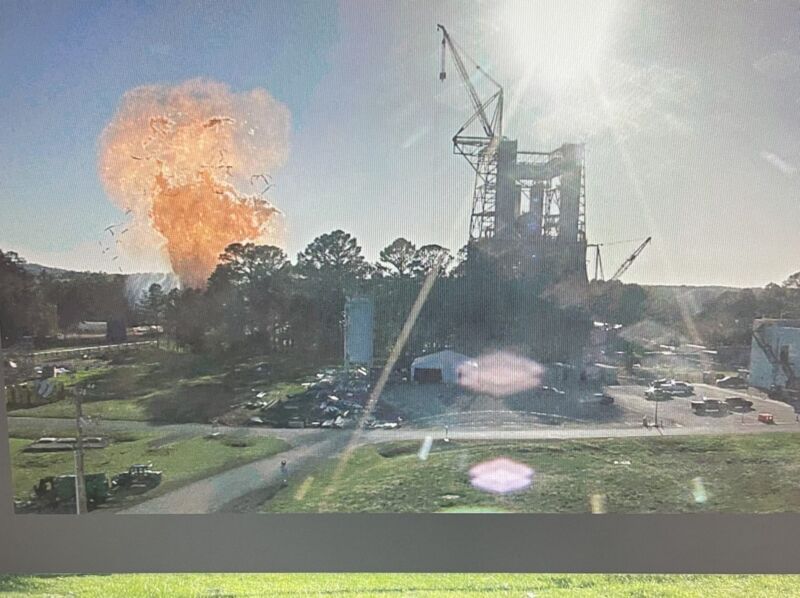
Anonymous source
10:30pm ET update: A few hours after this article was published, Ars got a freeze frame of the Centaur V anomaly that occurred on March 29 during testing of the Vulcan rocket’s upper stage. The photo shows the anomaly – a fireball of hydrogen igniting – to the left of Blue Origin’s rocket engine test rig.
After the author posted this photo to Twitter, United Launch Alliance CEO Tory Bruno provided a more detailed assessment of the anomaly. “Most of what you see is insulation and smaller pieces of the test rig. A piece of the hydrogen tank dome, about a meter square, ended up a few feet away. The test article is still in the rig and is largely intact, which will significantly assist in the investigation”, said Bruno through Twitter.
Original message: On the evening of March 29, United Launch Alliance at the Marshall Space Flight Center in Alabama began pressurizing the upper stage of its new Vulcan rocket. But then suddenly something went wrong with this Centaur upper stage.
Shortly after the incident, United Launch Alliance CEO Tory Bruno acknowledged to his credit on Twitter that something had happened: “I’ll keep you posted: While testing the quality of the Centaur V structural article at MSFC, the hardware encountered an anomaly.”
Bruno unpacks this tweet a bit, saying that during qualification testing — the process of testing rocket motors and stages on the ground to determine their behavior during flight-like conditions — the Centaur stage had a problem. More than a week later, however, there are more questions than answers about the accident.
A mushroom cloud
Multiple sources confirmed to Ars that there was a major explosion that Wednesday night, which sent several first responders to the scene at NASA’s field center where the company has a test stand. No one was injured, but the accident made for dramatic images.
“A column of burning, clear hydrogen shot up into a mushroom cloud that dwarfed the test stand,” said a source. “Their test article is definitely more than just ‘damaged’.”
The anomaly was captured on video cameras operated by Blue Origin, which is restoring a nearby test bed. Located about 100 yards from the United Launch Alliance facility, Blue Origin has invested more than $100 million in NASA’s old Test Stand 4670 for acceptance testing of its BE-4 and BE-3U rocket engines.
A Blue Origin source confirmed that a mushroom cloud formed from the anomaly. Afterwards, United Launch Alliance asked Blue Origin to remove the explosive video footage from the company’s computers, to which Blue Origin agreed.
(Remark: After publishing this article, when asked about removing the video, Bruno tweeted that this “didn’t happen”. However, two sources told Ars that after the incident, United Launch Alliance asked Blue Origin to “secure” the video for its investigation. Blue Origin did so, but also removed the video from its own internal servers, reserving access only to a few company officials).
The loss of the Centaur’s upper stage raises questions about ULA’s schedule for the debut launch of the long-awaited Vulcan heavy-lift missile. For a few years now, ULA has said it was waiting for Blue Origin to supply BE-4 engines for the rocket’s first stage. The fact that ULA was still in qualifying testing of the Centaur’s upper stage suggests it was also a pace item for the new launcher.
While this Centaur V upper stage is based on a heritage design, the new version nonetheless features significant upgrades. Previously, Bruno said Centaur V could fly 40 percent longer in flight and would have two and a half times more energy than the Centaur upper stage ULA currently flying.
Another unanswered question concerns exactly what Centaur stage ULA was testing in Alabama. Was it a full flight-like stage to use for a future mission? Or was it more of a prototype stage used for development testing, which may be more prone to error? ULA would not comment on this.
Vulcan’s debut
Publicly, ULA has set a May 4 target date for the debut launch of the Vulcan rocket. However, last month, even before the Centaur anomaly occurred, Ars reported that this date was likely to slip as early as summer based on the company’s internal timelines. The effect of the Centaur Anomaly on Vulcan’s scheme is still unclear.
“We are conducting an investigation and will fly when we think it is safe to launch,” ULA spokesperson Jessica Rye told Ars this week. “We won’t know the impact on the launch date until we learn more information from the study.”
ULA has asked the Cert-1 mission’s lead customer, Astrobotic, not to ship its Peregrine lander to the launch site. The lunar lander will remain at the company’s facilities in Pittsburgh, awaiting the green light from the rocket company.
After the accident, Bruno speculated on Twitter that it was “very unlikely” to have implications for the Centaur V upper stage currently located in Florida and planned for use on Vulcan’s Cert-1 mission. However, any decision on this will have to wait until ULA completes its accident investigation and consults with the US Space Force, which will eventually certify the missile for national security launches.
Time is running out for ULA to complete Vulcan development and fly two certification missions this year. This would allow the vehicle to begin flying national security payloads for the Space Force. ULA had hoped to fly its first national security mission in 2023, but that now seems all but impossible.

